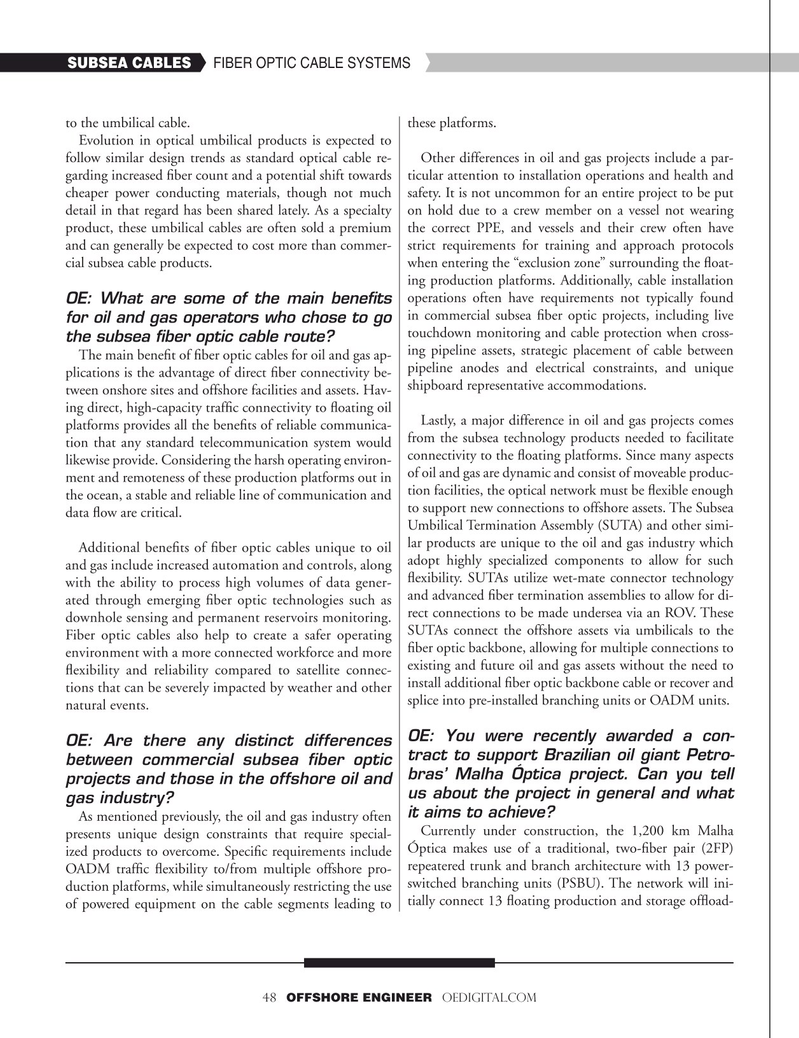
Page 48: of Offshore Engineer Magazine (May/Jun 2023)
Read this page in Pdf, Flash or Html5 edition of May/Jun 2023 Offshore Engineer Magazine
SUBSEA CABLES FIBER OPTIC CABLE SYSTEMS to the umbilical cable. these platforms.
Evolution in optical umbilical products is expected to follow similar design trends as standard optical cable re- Other differences in oil and gas projects include a par- garding increased fber count and a potential shift towards ticular attention to installation operations and health and cheaper power conducting materials, though not much safety. It is not uncommon for an entire project to be put detail in that regard has been shared lately. As a specialty on hold due to a crew member on a vessel not wearing product, these umbilical cables are often sold a premium the correct PPE, and vessels and their crew often have and can generally be expected to cost more than commer- strict requirements for training and approach protocols cial subsea cable products. when entering the “exclusion zone” surrounding the foat- ing production platforms. Additionally, cable installation operations often have requirements not typically found
OE: What are some of the main benefits in commercial subsea fber optic projects, including live for oil and gas operators who chose to go touchdown monitoring and cable protection when cross- the subsea fiber optic cable route?
ing pipeline assets, strategic placement of cable between
The main beneft of fber optic cables for oil and gas ap- pipeline anodes and electrical constraints, and unique plications is the advantage of direct fber connectivity be- shipboard representative accommodations.
tween onshore sites and offshore facilities and assets. Hav- ing direct, high-capacity traffc connectivity to foating oil
Lastly, a major difference in oil and gas projects comes platforms provides all the benefts of reliable communica- tion that any standard telecommunication system would from the subsea technology products needed to facilitate connectivity to the foating platforms. Since many aspects likewise provide. Considering the harsh operating environ- ment and remoteness of these production platforms out in of oil and gas are dynamic and consist of moveable produc- the ocean, a stable and reliable line of communication and tion facilities, the optical network must be fexible enough to support new connections to offshore assets. The Subsea data fow are critical.
Umbilical Termination Assembly (SUTA) and other simi-
Additional benefts of fber optic cables unique to oil lar products are unique to the oil and gas industry which and gas include increased automation and controls, along adopt highly specialized components to allow for such fexibility. SUTAs utilize wet-mate connector technology with the ability to process high volumes of data gener- ated through emerging fber optic technologies such as and advanced fber termination assemblies to allow for di- downhole sensing and permanent reservoirs monitoring. rect connections to be made undersea via an ROV. These
Fiber optic cables also help to create a safer operating SUTAs connect the offshore assets via umbilicals to the environment with a more connected workforce and more fber optic backbone, allowing for multiple connections to existing and future oil and gas assets without the need to fexibility and reliability compared to satellite connec- tions that can be severely impacted by weather and other install additional fber optic backbone cable or recover and splice into pre-installed branching units or OADM units.
natural events.
OE: Are there any distinct differences OE: You were recently awarded a con- between commercial subsea fiber optic tract to support Brazilian oil giant Petro- projects and those in the offshore oil and bras’ Malha Óptica project. Can you tell us about the project in general and what gas industry?
it aims to achieve?
As mentioned previously, the oil and gas industry often
Currently under construction, the 1,200 km Malha presents unique design constraints that require special- ized products to overcome. Specifc requirements include Óptica makes use of a traditional, two-fber pair (2FP) repeatered trunk and branch architecture with 13 power-
OADM traffc fexibility to/from multiple offshore pro- duction platforms, while simultaneously restricting the use switched branching units (PSBU). The network will ini- of powered equipment on the cable segments leading to tially connect 13 foating production and storage offoad- 48 OFFSHORE ENGINEER OEDIGITAL.COM

 47
47

 49
49